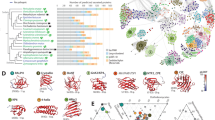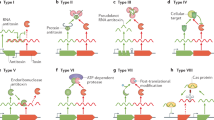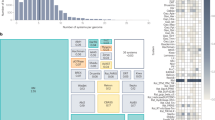Abstract
An important mechanism underlying the strategies used by microbial pathogens to manipulate cellular functions is that of functional mimicry of host activities. In some cases, mimicry is achieved through virulence factors that are direct homologues of host proteins. In others, convergent evolution has produced new effectors that, although having no obvious amino-acid sequence similarity to host factors, are revealed by structural studies to display mimicry at the molecular level.
This is a preview of subscription content, access via your institution
Access options
Subscribe to this journal
Receive 51 print issues and online access
$199.00 per year
only $3.90 per issue
Buy this article
- Purchase on Springer Link
- Instant access to full article PDF
Prices may be subject to local taxes which are calculated during checkout



Similar content being viewed by others
References
Guan, K. & Dixon, J. E. Protein tyrosine phosphatase activity of an essential virulence determinant in Yersinia. Science 249, 553–556 (1990).
Hardt, W.-D., Chen, L.-M., Schuebel, K. E., Bustelo, X. R. & Galán, J. E. Salmonella typhimurium encodes an activator of Rho GTPases that induces membrane ruffling and nuclear responses in host cells. Cell 93, 815–826 (1998).
Hamburger, Z. A., Brown, M. S., Isberg, R. R. & Bjorkman, P. J. Crystal structure of invasin: a bacterial integrin-binding protein. Science 286, 291–295 (1999).
Fu, Y. & Galán, J. E. A Salmonella protein antagonizes Rac-1 and Cdc42 to mediate host-cell recovery after bacterial invasion. Nature 401, 293–297 (1999).
Stebbins, C. E. & Galán, J. E. Modulation of host signaling by a bacterial mimic. Structure of the Salmonella effector SptP bound to Rac1. Mol. Cell 6, 1449–1460 (2000).
Galyov, E. E., Hakansson, S., Forsberg, A. & Wolf-Watz, H. A secreted protein kinase of Yersinia pseudotuberculosis is an indispensable virulence determinant. Nature 361, 730–732 (1993).
Norris, F. A., Wilson, M. P., Wallis, T. S., Galyov, E. E. & Majerus, P. W. SopB, a protein required for virulence of Salmonella dublin, is an inositol phosphate phosphatase. Proc. Natl Acad. Sci. USA 95, 14057–14059 (1998).
Zhou, D., Mooseker, M. & Galán, J. E. Role of the S. Typhimurium actin-binding protein SipA in bacterial internalization. Science 283, 2092–2095 (1999).
Lerm, M., Schmidt, G. & Aktories, K. Bacterial protein toxins targeting rho GTPases. FEMS Microbiol. Lett. 188, 1–6 (2000).
Alouf, J. E. Bacterial protein toxins. An overview. Methods Mol. Biol. 145, 1–26 (2000).
Montecucco, C., Papini, E. & Schiavo, G. Bacterial protein toxins and cell vesicle trafficking. Experimentia 52, 1026–1032 (1996).
Haag, F. & Koch-Nolte, F. Endogenous relatives of ADP-ribosylating bacterial toxins in mice and men: potential regulators of immune cell function. J. Biol. Regul. Homeost. Agents 12, 53–62 (1998).
Galán, J. E. & Collmer, A. Type III secretion machines: bacterial devices for protein delivery into host cells. Science 284, 322–328 (1999).
Stuckey, J. A. et al. Crystal structure of Yersinia protein tyrosine phosphatase at 2.5 Å and the complex with tungstate. Nature 370, 571–575 (1994).
Kaniga, K., Uralil, J., Bliska, J. B. & Galán, J. E. A secreted tyrosine phosphatase with modular effector domains encoded by the bacterial pathogen Salmonella typhimurium. Mol. Microbiol. 21, 633–641 (1996).
Persson, C., Carballeira, N., Wolf-Watz, H. & Fallman, M. The PTPase YopH inhibits uptake of Yersinia, tyrosine phosphorylation of p130Cas and FAK, and the associated accumulation of these proteins in peripheral focal adhesions. EMBO J. 16, 2307–2318 (1997).
Black, D. S. & Bliska, J. B. Identification of p130Cas as a substrate of Yersinia YopH (Yop51), a bacterial protein tyrosine phosphatase that translocates into mammalian cells and targets focal adhesions. EMBO J. 16, 2730–2744 (1997).
Orth, K. et al. Disruption of signaling by the Yersinia effector YopJ, a ubiquitin-like protein protease. Science 290, 1594–1597 (2000).
Isberg, R. R. & Leong, J. M. Multiple beta 1 chain integrins are receptors for invasin, a protein that promotes bacterial penetration into mammalian cells. Cell 60, 861–871 (1990).
Goehring, U. M., Schmidt, G., Pederson, K. J., Aktories, K. & Barbieri, J. T. The N-terminal domain of Pseudomonas aeruginosa exoenzyme S is a GTPase-activating protein for Rho GTPases. J. Biol. Chem. 274, 36369–36372 (1999).
Von Pawel-Rammingen, U. et al. GAP activity of the Yersinia YopE cytotoxin specifically targets the rho pathway: a mechanism for disruption of actin microfilament structure. Mol. Microbiol. 36, 737–748 (2000).
Wurtele, M. et al. How the Pseudomonas aeruginosa ExoS toxin downregulates Rac. Nature Struct. Biol. 8, 23–26 (2001).
Galán, J. E. & Zhou, D. Striking a balance: modulation of the actin cytoskeleton by Salmonella. Proc. Natl Acad. Sci. USA 97, 8754–8761 (2000).
Stender, S. et al. Identification of SopE2 from Salmonella typhimurium, a conserved guanine nucleotide exchange factor for Cdc42 of the host cell. Mol. Microbiol. 36, 1206–1221 (2000).
Nassar, N., Hoffman, G. R., Mannor, D., Clardy, J. C. & Cerione, R. A. Structures of Cde42 bound to the active and catalytically compromised forms of Cdc42GAP. Nature Struct. Biol. 5, 1047–1052 (1998).
Rittinger, K., Walker, P. A., Eccleston, J. F., Smerdon, S. J. & Gamblin, S. J. Structure at 1.65 Å of RhoA and its GTPase-activating protein in complex with a transition-state analogue. Nature 389, 758–762 (1997).
Scheffzek, K. et al. The Ras-RasGAP complex: structural basis for GTPase activation and its loss in oncogenic Ras mutants. Science 277, 333–338 (1997).
Scheffzek, K., Ahmadian, M. R. & Wittinghofer, A. GTPase-activating proteins: helping hands to complement an active site. Trends Biochem. 23, 7257–7262 (1998).
Isberg, R. R., Hamburger, Z. & Dersch, P. Signaling and invasin-promoted uptake via integrin receptors. Microbes Infect. 2, 793–801 (2000).
Tran Van Nhieu, G. & Isberg, R. R. The Yersinia pseudotuberculosis invasin protein and human fibronectin bind to mutually exclusive sites on the alpha 5 beta 1 integrin receptor. J. Biol. Chem. 266, 24367–24375 (1991).
Tran Van Nhieu, G. & Isberg, R. R. Bacterial internalization mediated by beta 1 chain integrins is determined by ligand affinity and receptor density. EMBO J. 12, 1887–1895 (1993).
Leahy, D. J. Aukhil, I. & Erickson, H. P. 2.0 Å crystal structure of a four-domain segment of human fibronectin encompassing the RGD loop and synergy region. Cell 84, 155–164 (1996).
Reyrat, J. M. et al. Towards deciphering the Helicobacter pylori cytotoxin. Mol. Microbiol. 34, 197–204 (1999).
Cossart, P. & Lecuit, M. Interactions of Listeria monocytogenes with mammalian cells during entry and actin-based movement: bacterial factors, cellular ligands and signaling. EMBO J. 17, 3797–3806 (1998).
Braun, L., Ghebrehiwet, B. & Cosart, P. gC1q-R/p32, a C1q-binding protein, is a receptor for the InlB invasion protein of Listeria monocytogenes. EMBO J. 19, 1458–1466 (2000).
Shen, Y., Naujokas, M., Park, M. & Ireton, K. InlB-dependent internalization of Listeria is mediated by the met receptor tyrosine kinase. Cell 103, 501–510 (2000).
Kobe, B. & Deisenhofer, J. The leucine-rich repeat: a versatile binding motif. Trends Biochem. Sci. 19, 415–421 (1994).
Marino, M., Braun, L., Cossart, P. & Ghosh, P. Structure of the InlB leucine-rich repeats, a domain that triggers host cell invasion by the bacterial pathogen Listeria monocytogenes. Mol. Cell 4, 1063–1072 (1999).
Hardt, W.-D., Urlaub, H. & Galán, J. E. A target of the centisome 63 type III protein secretion system of Salmonella typhimurium is encoded by a cryptic bacteriophage. Proc. Natl Acad. Science USA 95, 2574–2579 (1998).
Hayward, R. D. & Koronakis, V. Direct nucleation and bundling of actin by the SipC protein of invasive Salmonella. EMBO J. 18, 4926–4934 (1999).
Tran Van Nhieu, G., Ben-Ze'ev, A. & Sansonetti, P. J. Modulation of bacterial entry into epithelial cells by association between vinculin and the Shigella IpaA invasin. EMBO J. 16, 2717–2729 (1997).
Chen, Y., Smith, M. R., Thirumalai, K. & Zychlinsky, A. A bacterial invasin induces macrophage apoptosis by binding directly to ICE. EMBO J. 15, 3853–3860 (1996).
Bourdet-Sicard, R., Egile, C., Sansonetti, P. J. & Tran Van Nhieu, G. Diversion of cytoskeletal processes by Shigella during invasion of epithelial cells. Microbes Infect. 2, 813–819 (2000).
Goosney, D. L., Gruenheid, S. & Finlay, B. B. Gut feelings: enteropathogenic E. coli (EPEC) interactions with the host. Annu. Rev. Cell Dev. Biol. 16, 173–189 (2000).
Acknowledgements
C.E.S. was supported by a fellowship of the Cancer Research Fund of the Damon Runyon–Walter Winchell Foundation. This work was supported by Public Health Services grants to J.E.G.
Author information
Authors and Affiliations
Corresponding author
Rights and permissions
About this article
Cite this article
Stebbins, C., Galán, J. Structural mimicry in bacterial virulence. Nature 412, 701–705 (2001). https://doi.org/10.1038/35089000
Issue Date:
DOI: https://doi.org/10.1038/35089000
This article is cited by
-
Everybody Lies: Deception Levels in Various Domains of Life
Biosemiotics (2022)
-
PathFams: statistical detection of pathogen-associated protein domains
BMC Genomics (2021)
-
Genomic features of bacterial adaptation to plants
Nature Genetics (2018)
-
Biofluid lipidome: a source for potential diagnostic biomarkers
Clinical and Translational Medicine (2017)
-
The PPE2 protein of Mycobacterium tuberculosis translocates to host nucleus and inhibits nitric oxide production
Scientific Reports (2017)
Comments
By submitting a comment you agree to abide by our Terms and Community Guidelines. If you find something abusive or that does not comply with our terms or guidelines please flag it as inappropriate.



